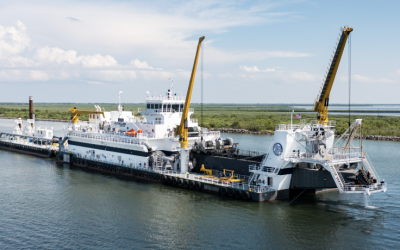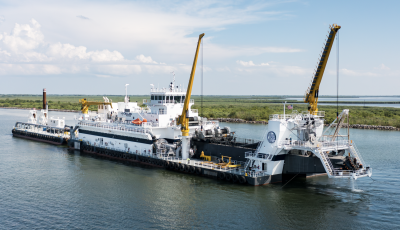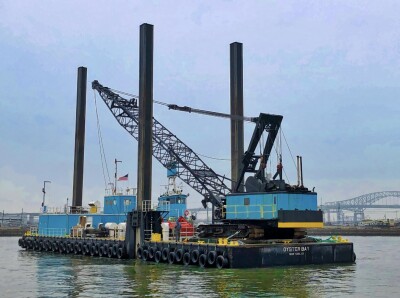At this week's International WorkBoat Show, dredging industry experts discussed the sector’s major advancements and trends in a panel titled “The U.S. Dredging Boom: Trends, Technologies, and Future Directions”.
Panelists included Bill Doyle, CEO and executive director of Dredging Contractors of America, Fred Paup, board chairman and executive vice president of Manson Construction Co., David Johanson, senior vice president of Great Lakes Dredge and Dock, and Eddie Compass IV, CEO of Next Generation Logistics LLC.
One of the most notable transformations in the dredging industry has been the shift in how dredged material is managed. Historically, dredge material was often considered waste and disposed of at sea. Today, however, there is growing recognition of its potential value, especially for environmental restoration and infrastructure projects.
Bill Doyle explained, "I have a saying that I tell folks, that land is only built two ways: volcanic eruptions and dredged material are excavated from the ocean floor and beneficially reused." He pointed out that, especially in regions like Maryland, dredge material is now being used to rebuild islands in Chesapeake Bay and to protect coastal areas. "In 2022, we put together a $4 billion project with the Army Corps of Engineers to finish Poplar Island and begin rebuilding other critical areas like Baron James Islands," Doyle shared. This change was largely driven by local and state regulatory pressures, such as Maryland’s decision in the late 1980s to prohibit the dumping of dredged material in Chesapeake Bay.
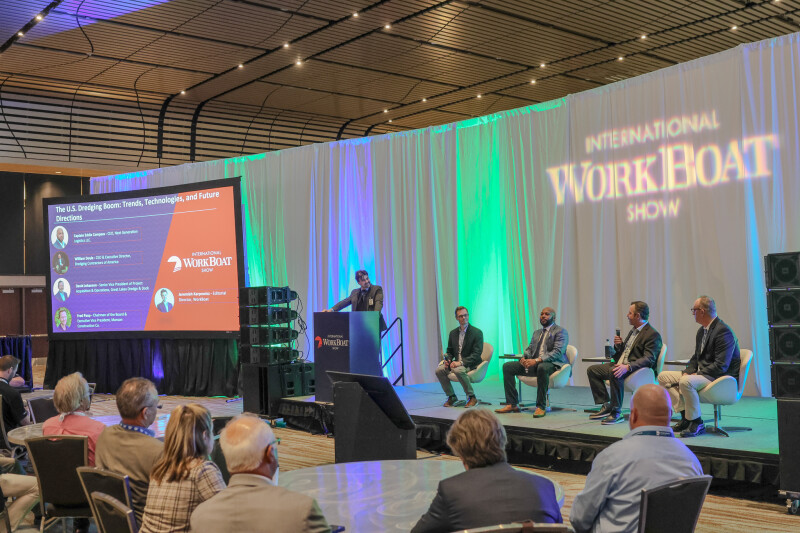
“What Maryland came up with is an innovative use of dredging material for products. For instance, when I was there (as the Maryland Port Administration executive director), we had Belden Brick Company come in. They built the bricks for Camden Yards baseball stadium. So they came in and they took a look at this…material, that's the material that we can't use on the islands, and said, ‘Hey, is there a use of this?’ And they started building bricks, red brick material.” Innovative applications, such as using dredge material for brick production or reinforcing areas like Top Golf in Baltimore, are examples of how this material can be repurposed for urban development and environmental sustainability.
Fred Paup added that in addition to environmental considerations, the growing threat of sea-level rise has heightened the demand for using dredged material in coastal protection projects. “Tourism dollars, infrastructure protection, and the growing demand for coastal restoration are driving forces behind the increased use of dredged material,” he said.
As the dredging industry evolves, companies are increasingly relying on specialized equipment to meet the diverse needs of clients. David Johanson, a panelist from one of the largest U.S. dredging firms (Great Lakes Dredge and Dock), discussed the importance of fleet specialization in supporting future growth. His company operates a diverse fleet of over 200 vessels, ranging from hydraulic cutters to hopper dredges and clamshell dredges. "Having such a wide array of dredging equipment enables us to provide cost-effective solutions for different projects," Johanson explained. "Certain elements of a project might be better suited for a specific type of dredge, and our fleet gives us the flexibility to optimize costs."
Johanson also emphasized the importance of having extensive pipeline resources to support projects that involve beneficial use of dredged material. "We have over 200,000 feet of steel pipeline, which is critical for pumping material over long distances, supporting upland work and future nourishment projects."
However, the expansion of fleet capacity comes with challenges. "The dredging industry is very capital intensive…. When you have a big fleet size, you have a lot of mouths to feed," Johanson noted, referring to the high operating costs associated with maintaining such a large fleet. "Slowdowns in the industry can really put a damper on your earnings, but when the market is strong, a diversified fleet is an advantage."
His sentiment aligns with a recently released market report that shows over $3 billion in dredging newbuilds. Johanson also suggested that this investment might not be as beneficial to the sector as it's seems on the surface.
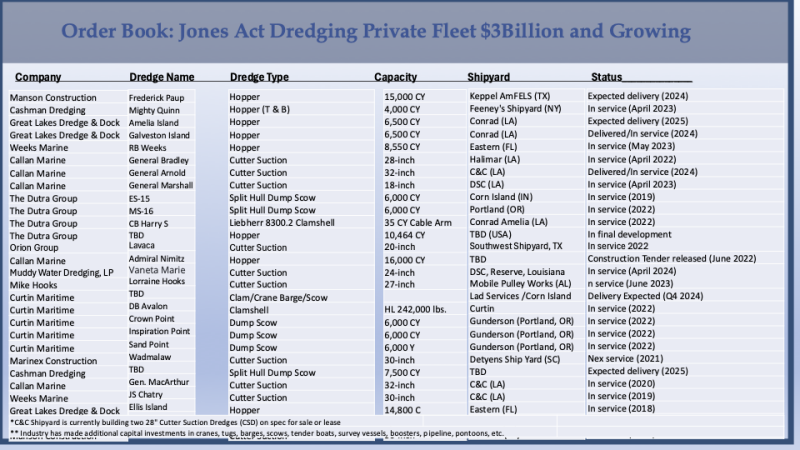
“So there's this discussion about, well, we are in a boom market right now,” Johanson said. “I'll actually say it's more like a surge market. Let's not forget, two years ago, all of us dredging contractors had dredges tied up to the dock or were unable to get projects out on the street. And so, what happened is that delayed all the projects that were in the pipeline, and so they're out now. So there's a heavy demand for hopper dredging currently. It's my projection that that will moderate back to normal levels probably this coming year,” he concluded.
Despite this, Paup noted that the industry's capital investments in newer, more efficient dredges are crucial for maintaining competitiveness.
While the U.S. Army Corps of Engineers is a major client for dredging companies, the private sector is also becoming an increasingly important driver of innovation in the industry. Eddie Compass IV, a panelist with expertise in private sector dredging, discussed how the demand from private clients — such as oil and gas companies, marinas, and terminal operators — is shaping the future of dredging.
"The private sector is more nimble, with a much shorter procurement process compared to the federal government," Compass explained. "And with the rise of large-scale infrastructure projects like LNG facilities, private clients are looking for dredging solutions to meet their specific needs."
He highlighted the shift towards coastal restoration and the role dredging plays in mitigating the impact of sea-level rise. "Private clients are becoming more environmentally conscious, and we’re seeing a shift toward using dredged material for coastal restoration and land reclamation projects."
In the private sector, Compass noted that dredging companies are increasingly focused on efficiency and cost-effectiveness. "The trend is clear, clients want more production at a lower price," he said. This pressure is pushing companies to adopt more advanced technologies, such as Tier 4 engines for reduced emissions, and explore ways to use artificial intelligence (AI) to optimize dredging operations.
Looking to the future, several key challenges and trends are shaping the direction of the dredging industry.
As climate change and rising sea levels continue to impact coastal communities, the demand for dredging to support infrastructure protection and coastal restoration is expected to grow. However, the industry must continue to navigate complex environmental regulations to ensure that dredged material is safely and effectively repurposed.
Doyle said that this regulatory landscape is often fragmented, with local, state, and federal agencies all having their own requirements. "Getting buy-in from environmental groups was a huge challenge," he said, highlighting the importance of collaboration and scientific research to demonstrate the safety and value of dredged material for reclamation projects.
One of the most pressing challenges facing the dredging industry today, a challenge felt among the maritime industry as a whole, is workforce development. Compass raised concerns about the aging workforce in the sector and the difficulties companies face in attracting younger workers. “It’s a different world now,” Compass said, acknowledging the need for a more diverse and younger workforce. "You’ve got this new generation coming in, and we have to find a way to engage them in a meaningful way. It’s not just about bringing them in, it's about keeping them motivated and helping them see the value in this line of work."
Compass also highlighted the importance of collaboration among companies, both large and small. "We need to come together, even with the larger companies. They’re our clients as well, and they have a mandate to use small businesses,” he explained. "I talk to the CEOs of Manson, Great Lakes, Weeks (Marine), and others, and I see opportunities for collaboration. It’s a unique position to be in, where the competitive environment is tough, but there’s also room for smaller companies to carve out a space and work alongside the bigger players."
Paup quickly followed discussing the collaboration component. “We're a pretty competitive industry, and yet, sometimes you have to call your competitor and say, ‘Hey, do you have this kind of pump? We'll order the new one. You can have that pump. We'll take your pump.’ We do things like that all the time. It happens. Once a month we're doing something with a competitor where you're trying to help them out and (they) try to help you out. Because the maritime industry, although the dollars are big, so many billions, it's still a small industry. There really are only so many suppliers that can provide these various parts of things,” Paup said. “So, you know, we don't have the same size fleet as Great Lakes does, but we do have a lot of very specialized equipment that is very competitive. And I think that's true across the industry, not just Manson.”

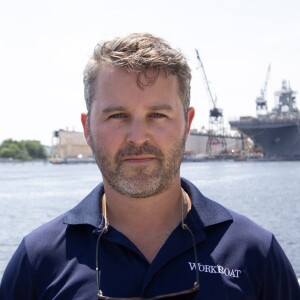
.jpeg.medium-cropped.800x500.jpg)
